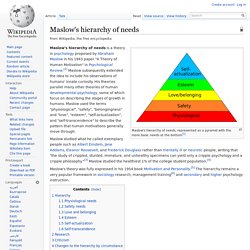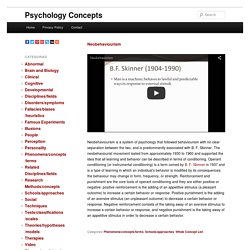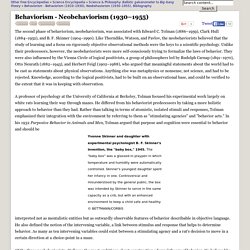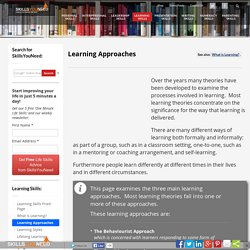

Bloom's Digital Taxonomy Video. Bloom’s Taxonomy. Background Information | The Original Taxonomy | The Revised Taxonomy | Why Use Bloom’s Taxonomy? | Further Information The above graphic is released under a Creative Commons Attribution license. You’re free to share, reproduce, or otherwise use it, as long as you attribute it to the Vanderbilt University Center for Teaching. For a higher resolution version, visit our Flickr account and look for the “Download this photo” icon. Background Information In 1956, Benjamin Bloom with collaborators Max Englehart, Edward Furst, Walter Hill, and David Krathwohl published a framework for categorizing educational goals: Taxonomy of Educational Objectives.
The framework elaborated by Bloom and his collaborators consisted of six major categories: Knowledge, Comprehension, Application, Analysis, Synthesis, and Evaluation. The Original Taxonomy (1956) Here are the authors’ brief explanations of these main categories in from the appendix of Taxonomy of Educational Objectives (Handbook One, pp. 201-207): Constructivism - Learning Theories. Constructivism as a Paradigm for Teaching and Learning.
What is constructivism?

Abraham Maslow and the Theory of Humanistic Learning. Maslow, Abraham H. (1908-1970) Humanistic Theory of Learning 1908 – 1970, Born in Brooklyn NY Ph.D., Univ. of Wisconsin, 1934 Theory Abraham Maslow has been considered the Father of Humanistic Psychology.

Maslow's theory is based on the notion that experience is the primary phenomenon in the study of human learning and behavior. He placed emphasis on choice, creativity, values, self-realization, all distinctively human qualities, and believed that meaningfulness and subjectivity were more important than objectivity. Humanism. Throughout recorded history there have been non-religious people who have believed that this life is the only life we have, that the universe is a natural phenomenon with no supernatural side, and that we can live ethical and fulfilling lives on the basis of reason and humanity.

They have trusted to the scientific method, evidence, and reason to discover truths about the universe and have placed human welfare and happiness at the centre of their ethical decision making. Today, people who share these beliefs and values are called humanists and this combination of attitudes is called Humanism. Many millions of people in Britain share this way of living and of looking at the world, but many of them have not heard the word ‘humanist’ and don’t realise that it describes what they believe. Defining ‘Humanism’ Roughly speaking, the word humanist has come to mean someone who: Psychology History. Tolman - Latent Learning. The behaviorists stated that psychology should study actual observable behavior, and that nothing happens between stimulus and response (i.e. no cognitive processes take place).

Edward Tolman (1948) challenged these assumptions by proposing that people and animals are active information processes and not passive learners as behaviorism had suggested. Tolman developed a cognitive view of learning that has become popular in modern psychology. Tolman believed individuals do more than merely respond to stimuli; they act on beliefs, attitudes, changing conditions, and they strive toward goals. Tolman is virtually the only behaviorists who found the stimulus-response theory unacceptable, because reinforcement was not necessary for learning to occur. He felt behavior was mainly cognitive. Tolman coined the term cognitive map, which is an internal representation (or image) of external environmental feature or landmark. Procedure Group 1: Rewarded. Cognitivism - Learning Theories. Bandura and Observational Learning. Maslow's hierarchy of needs. Maslow's hierarchy of needs, represented as a pyramid with the more basic needs at the bottom[1] Maslow's hierarchy of needs is a theory in psychology proposed by Abraham Maslow in his 1943 paper "A Theory of Human Motivation" in Psychological Review.[2] Maslow subsequently extended the idea to include his observations of humans' innate curiosity.

His theories parallel many other theories of human developmental psychology, some of which focus on describing the stages of growth in humans. Maslow used the terms "physiological", "safety", "belongingness" and "love", "esteem", "self-actualization", and "self-transcendence" to describe the pattern that human motivations generally move through. Maslow's theory was fully expressed in his 1954 book Motivation and Personality.[5] The hierarchy remains a very popular framework in sociology research, management training[6] and secondary and higher psychology instruction.
Hierarchy Physiological needs. Honey and Mumford. Taken from How to be an e-tutor by Dr Richard Mobbs.

Used with permission. Learning styles were developed by Peter Honey and Alan Mumford, based upon the work of Kolb, and they identified four distinct learning styles or preferences: Activist, Theorist; Pragmatist and Reflector. These are the learning approaches that individuals naturally prefer and they recommend that in order to maximise one's own personal learning each learner ought to: understand their learning styleseek out opportunities to learn using that style To understand your particular learning style Honey and Mumford have developed a Learning Style Questionnaire [see further reading] and with this information you will be in a far better position to do three really useful things [quoting P. "Become smarter at getting a better fit between learning opportunities and the way you learn best. Note: However, to be an effective learner you should also develop the ability to learn in other styles too. Characteristics Further reading.
Learning styles. Neobehaviorism. Behaviorism. Psychology Concepts. Neobehaviourism is a system of psychology that followed behaviourism with no clear separation between the two, and is predominantly associated with B.

F. Skinner. The neobehaviourist movement lasted from approximately 1930 to 1960 and supported the idea that all learning and behavior can be described in terms of conditioning. Operant conditioning (or instrumental conditioning) is a term coined by B. F. Behaviorism - Neobehaviorism (1930–1955) - Skinner, Hull, Psychology, and Learning. The second phase of behaviorism, neobehaviorism, was associated with Edward C.

Tolman (1886–1959), Clark Hull (1884–1952), and B. F. Skinner (1904–1990). Like Thorndike, Watson, and Pavlov, the neobehaviorists believed that the study of learning and a focus on rigorously objective observational methods were the keys to a scientific psychology. Unlike their predecessors, however, the neobehaviorists were more self-consciously trying to formalize the laws of behavior. A professor of psychology at the University of California at Berkeley, Tolman focused his experimental work largely on white rats learning their way through mazes. Of the three neobehaviorists, Hull was the most ambitious about constructing a formal theory of behavior. Behaviorism. By Saul McLeod published 2007, updated 2016 Behaviorism (also called behavioral psychology) refers to a psychological approach which emphasises scientific and objective methods of investigation.

The behaviorist movement began in 1913 when John Watson wrote an article entitled 'Psychology as the behaviorist views it', which set out a number of underlying assumptions regarding methodology and behavioral analysis: Basic Assumptions All behavior is learnt from the environment: Behaviorism emphasize the role of environmental factors in influencing behavior, to the near exclusion of innate of inherited factors. Learning Approaches. Over the years many theories have been developed to examine the processes involved in learning.

Most learning theories concentrate on the significance for the way that learning is delivered. Teaching Essentials-essential skills for the 21st century.